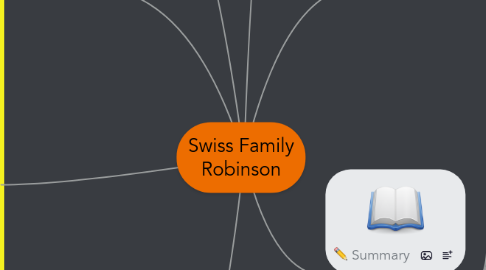Swiss Family Robinson
par Luke Darley


1. Author
1.1. Johann Wyss
1.2. 1743-1812
1.3. Swiss
1.4. Swiss author best remembered for his early nineteenth-century novel The Swiss Family Robinson. The book, one of the most popular in history, was published in 1812. Before fame, his famous novel, originally published as Der Schweizerische Robinson, was translated into English in 1814.
2. General Info
2.1. 1812
2.2. Adventure
2.3. Swiss
2.4. Island
3. Plot
3.1. The family is on a boat and is shipwrecked on an island
3.2. The island is very harsh but the family learns different things about the island that help them survive
3.3. Complication
3.4. The climax of the story is after 3 years, the family finally starts to feel like the island is their home. They know where everything is that they need. They do what they have to do to survive and they have done that and now they see the island as theirs.
3.5. As jack is fishing he finds a note mentioning a girl, they decide to look for her and when they find her, they find out she has been on the island for 3 years. They keep on living their life until they find a ship on the island. The ship has come to look for Jenny and finds the family there. Everyone has a big feast.
3.6. William and Elizabeth wonder if they should go back and they decide that two of their sons should go back to Switzerland. The next day it turns out that some people on the ship wanted to stay and make a colony. Ernest and Jack decide to stay, and Fritz and Franz decide to leave, not knowing Fritz would take Jenny's hand in marriage.
4. Themes, Allusions & Symbols
4.1. Symbols
4.2. The life of Pi is an allusion to Swiss Family Robinson because both were on large ships then rafts, the family had a tame jackal, Pi had a tiger. Its almost like its the Disney adaptation of Swiss Family Robinson.
4.3. It shows how a family helped each other survive during a hard time. This book has shown me that we should all help each other survive through the hard times.
5. Characters
5.1. William
5.2. His Family
5.3. The dangers of the island
6. Vocabulary
6.1. Section 1
6.1.1. Agouti
6.1.2. Rivulet
6.2. Section 2
6.2.1. Precipitous
6.2.2. Vehement
6.3. Section 3
6.3.1. fjord
6.3.2. damask
6.4. Section 4
6.4.1. phlegmatic
6.4.2. vociferous

